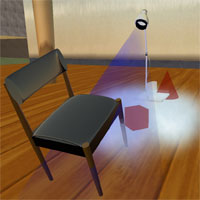'Remote' connects together two spaces, one in Boston the other in Second Life, and treats them as a single contiguous environment, bound together by the internet so that things that occur in one space affect things that happen in the other and vice versa - remotely controlling each other.



From Feb 7 to April 15, 2008 it was possible to see see:
- The Remote chair in Boston, Huret & Spector Gallery, Emerson College
- The Remote chair in Second Life, Ars Virtua
- PDF menu of interactions between the two spaces
- Real time data from the two spaces @ turbulence.org
Communication between the two halves of this extended environment is a complex choreography coupling the environmental phenomena of humidity, temperature, light, speech, mist, wind, sound and proximity across the two. The object in Boston appears to be a seat; but, experientially, the Second Life space appears to be inside the seat. A similar alteration of scale occurs in the other direction. Visitors to the Boston space and the Second Life space must negotiate to achieve goals: e.g. by sitting down, breathing, touching, knocking, colliding.
Imagine that hidden underneath the chair in Boston is a chair in Second Life (SL). But under the big chair in SL is a smaller chair (which looks a lot like the Boston chair). So under the SL small chair is the Boston chair, etc. etc. etc...
Boston's effect on Second Life:
- as humidity around the chair in Boston rises, the amount of mist around the SL chair increases
- as the light level falling on the Boston chair decreases (for example when you sit on it), the fog in SL gets darker
- as the temperature rises in Boston, the lamp in SL changes from blue to red
- as the light level on each side of the Boston chair changes (e.g. if you sit on it and wiggle from side to side), the SL chair starts to wiggle from side to side too
- the more times you sit on the Boston chair, the taller the SL chair becomes
- as time progresses in Boston, the SL big chair slowly rotates
Second Life's effect on Boston:
- as the number of avatars near the chair in SL increase, the Boston lamp will get brighter and brighter
- when someone sits on the SL small chair, the mist machine in Boston switches on
- if someone starts chatting near the SL chair, the lower blue fan in Boston starts blowing and pushes out the mist (if it's switched on... which means only if someone is sitting on the SL small chair!)
- every time an avatar collides with underside of the SL big chair, the Boston chair starts knocking underneath
- every time an avatar touches the SL big chair, it changes the colour of the Boston lamp
- as the wind in Second Life increases speed, the upper blue fan in Boston blows more strongly....
The environmental data of both spaces was publicly available in realtime via the EnvironmentXML repository enabling others to build devices and spaces that connect directly to both the Boston and Second Life spaces.

The intention is to explore an architecture that is resolutely "human" (in the sense of being inhabited, configured and determined by its occupants) yet context-free (because it does not privilege geographical location).
Remote is a 2007 commission of New Radio and Performing Arts, Inc., (aka Ether-Ore) for its Mixed Realities exhibition. It was made possible with funding from the Andy Warhol Foundation for the Visual Arts.